Until John Jonas Gruen decamped for the Upper West Side with his wife, the painter Jane Wilson, and their daughter Julia, he lived at 317 East 10th Street, around the corner from the headquarters of The East Village Other. While covering the burgeoning neighborhood, the journalist befriended EVO editors Allen Katzman and Dan Rattiner. He recently told The Local, “I was the one who brought the East Village phenomenon to Clay Felker, one of my editors [at the New York Herald Tribune], who suggested I write all about it.” Mr. Gruen captured the era in a Nov. 29, 1964 article in the Herald Tribune’s Sunday supplement (the precursor to New York magazine), and then later in his 1966 book, “The New Bohemia,” a portion of which is excerpted here.
Jefferson Poland [was] an East Villager [who] made a name for himself by creating the League for Sexual Freedom, an organization devoted to, among other things, the legalization of prostitution. But Poland is also something of a clairvoyant in that he sensed a need for an East Village newspaper, a neighborhood paper that would function for the area as The Village Voice does so successfully for Greenwich Village.
The gap has now been filled by The East Village Other, a biweekly publication started in October 1965 by Walter Bowart, a 27-year-old painter who gave it a slim, but provocative kickoff with one thousand dollars and an excess of drive. With typically offbeat headquarters located on Tompkins Square Park, The Other currently boasts a circulation of 7,000 and champions the causes of New Bohemia. The style is one of humorous candor and immediacy designed to reach the same mass-media audience that so fervently responds to the folk-rock wailings of Bob Dylan. Bowart has said: “I came to the conclusion that most official journalism was a big fat opinion. Because of the superego conditioning of this society, most reporters are only spewing out status quo propaganda. I wanted an intrepid broadside paper, like Poor Richard’s Almanack or The Tatler. I was ready to gamble a thousand bucks on three issues and now we’re here to stay because no one else is speaking to the New Left with laughter.
“My hero,” Bowart concluded, “is Will Rogers.”
A quick glance through the pages of The East Village Other reveals its point of view. Some of the headlines read, “Abolition of Jails,” “Illicit Tattoo Clubs,” “148 Avenue C: No Heat and a Child with Pneumonia,” “Johnson Lies to His Country About Viet Peace Offer,” “the Con Ed Con,” “Generation of Draft Dodgers.” Among its regular features are the comic strip “Captain High!”; a crossword puzzle called, appropriately, “Hippuzzle” (67 across: It’s hairy.” Answer: “Snatch.”); a monthly “Slum Goddess,” cute East Village pinup types; a regular column by former Village Voice columnist John Wilcock; and “Poor Paranoid’s Almanac,” another regular column, penned by East Village poet Allen Katzman.
The paper’s first editorial makes a succinct statement, not merely on the validity of an East Village newspaper, but also on the phenomenon of the New Bohemia itself. Under the headline “Why an East Village Newspaper?” Walter Bowart and his associates write:
During the past five years the West Village has grown into a side show of gnawing mediocrity and urban renewal, producing an exodus of its authentic population (young artists, poets, and writers) who have been thrown off by creeping tourism and rising rents, leaving the West Village to professional bohemians, “beatniks,” and mad-ave types. The natural migratory route from the west side, bordering the Hudson, was along Eighth Street toward the Lower East Side haven of low rent. Today the new “East Village” (a term we have to accept because it draws the distinction between the old world immigrants and the more recent west side immigrants) is the expanding real estate market of sometimes squalid, often quaint and authentic old New York streets that made famous the West Village of 25 or more years ago.
As the exodus continues it now becomes apparent that the East Side is destined for urban renewal and ‘civilization.’ Before that happens let us make our stand and try to guide its growth in the direction of renovation instead of ‘urban renewal’ and a sane policy of rent control, slumlord routing, better business, and safer streets.
…Aiming at the world in general, we hope to become the mirror of opinion of the new citizenry of the east Village.
John Jonas Gruen’s new book, “As Time Goes By,” gathers his portraits of the famous from the 1950s and 1960s. It launches Feb. 2 at the New Museum at an event sponsored by the Larry Rivers Foundation.
For more on “Blowing Minds: The East Village Other, the Rise of Underground Comix and the Alternative Press, 1965-72,” read about the exhibition here, and read more from EVO’s editors, writers, artists, and associates here.







